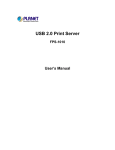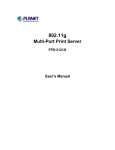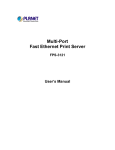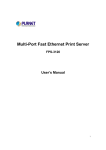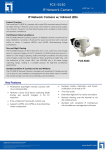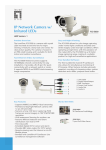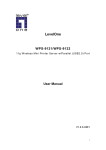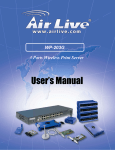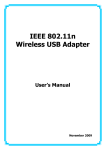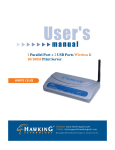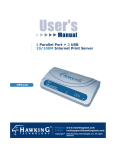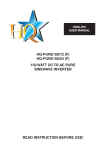Download Planet Technology FPS-1010G User's Manual
Transcript
802.11g USB2.0 Print Server FPS-1010G User’s Manual Copyright (C) 2005 PLANET Technology Corp. All rights reserved. The products and programs described in this User’s Manual are licensed products of PLANET Technology, This User’s Manual contains proprietary information protected by copyright, and this User’s Manual and all accompanying hardware, software, and documentation are copyrighted. No part of this User’s Manual may be copied, photocopied, reproduced, translated, or reduced to any electronic medium or machine-readable form by any means by electronic or mechanical. Including photocopying, recording, or information storage and retrieval systems, for any purpose other than the purchaser's personal use, and without the prior express written permission of PLANET Technology. Disclaimer PLANET Technology does not warrant that the hardware will work properly in all environments and applications, and makes no warranty and representation, either implied or expressed, with respect to the quality, performance, merchantability, or fitness for a particular purpose. PLANET has made every effort to ensure that this User’s Manual is accurate; PLANET disclaims liability for any inaccuracies or omissions that may have occurred. Information in this User’s Manual is subject to change without notice and does not represent a commitment on the part of PLANET. PLANET assumes no responsibility for any inaccuracies that may be contained in this User’s Manual. PLANET makes no commitment to update or keep current the information in this User’s Manual, and reserves the right to make improvements to this User’s Manual and/or to the products described in this User’s Manual, at any time without notice. If you find information in this manual that is incorrect, misleading, or incomplete, we would appreciate your comments and suggestions. CE mark Warning There are class A and class B device, In a domestic environment, this product may cause radio interference, in which case the user may be required to take adequate measures. Trademarks The PLANET logo is a trademark of PLANET Technology. This documentation may refer to numerous hardware and software products by their trade names. In most, if not all cases, these designations are claimed as trademarks or registered trademarks by their respective companies. Revision User’s Manual for PLANET 802.11g USB2.0 Print Server Model: FPS-1010G Rev: 1.0 (June. 2005) Part No. EM-FPS1010G Table of Contents CHAPTER1 INTRODUCTION............................................ 5 1.1 Product Introduction...............................................................................................................................5 1.2 Product Package....................................................................................................................................5 1.3 Print Server Outlook & LED Indicators...................................................................................................5 1.4 Network Printing Architecture ................................................................................................................6 1.4.1 Print Server Network Functions.......................................................................................................7 1.4.2 Network Printing Functions for Clients ............................................................................................8 1.4.3 Network Printing Functions for Network Server.............................................................................10 1.5 Network Printing Environment .............................................................................................................10 1.6 Contents of the User’s Manual.............................................................................................................11 1.7 Firmware & Printing Function...............................................................................................................12 CHAPTER2 HARDWARE INSTALLATION .................... 13 CHAPTER3 WINDOWS PEER-TO-PEER NETWORK ... 14 3.1 3.2 3.3 3.4 System Architecture.............................................................................................................................14 Administrator Installation and Setup ....................................................................................................14 Administrator Utilities ...........................................................................................................................21 Client Installation and Setup ................................................................................................................23 CHAPTER4 4.1 4.2 4.3 WINDOWS NT/2000 NETWORK................. 24 System Architecture.............................................................................................................................24 Windows NT/2000 Server Installation and Setup.................................................................................24 User Installation and Setup..................................................................................................................25 CHAPTER5 NETWARE NETWORK ............................... 26 5.1 System Architecture.............................................................................................................................26 5.2 NetWare 3.x/4.x/5.x Installation & Setup..............................................................................................26 5.2.1 Installation with Pconsole ..............................................................................................................27 CHAPTER6 UNIX SYSTEM NETWORK ......................... 29 6.1 Introduction ..........................................................................................................................................29 6.2 Enable Print Server’s TCP/IP Support .................................................................................................29 6.3 Setup Print Server’s IP Address...........................................................................................................29 6.3.1 DHCP ............................................................................................................................................29 6.3.2 BOOTP..........................................................................................................................................29 6.4 Verify Print Server’s IP Address...........................................................................................................30 6.5 Configure Remote LPD Printing on the Host .......................................................................................31 CHAPTER7 CONFIGURATION UTILITY ........................ 33 7.1 Introduction ..........................................................................................................................................33 7.2 Search for All Available Print Server ....................................................................................................34 7.3 Status of Print Server...........................................................................................................................35 7.4 Setting up the Print Server...................................................................................................................36 7.5 General Configuration..........................................................................................................................37 7.6 TCP/IP Configuration ...........................................................................................................................38 7.7 Netware Configuration .........................................................................................................................39 7.8 AppleTalk Configuration.......................................................................................................................40 7.9 System Configuration...........................................................................................................................41 7.10 Wireless ...............................................................................................................................................42 7.10.1 Infrastructure Mode .......................................................................................................................42 7.10.2 Ad-Hoc Mode ................................................................................................................................48 7.11 SNMP ..................................................................................................................................................52 7.12 Wizard..................................................................................................................................................53 7.13 Report ..................................................................................................................................................58 CHAPTER8 WEB MANAGEMENT.................................. 59 8.1 Introduction ..........................................................................................................................................59 8.2 Web Management of Print Server ........................................................................................59 8.2.1 Login .............................................................................................................................................59 8.3 Device Status.......................................................................................................................................60 8.3.1 System ..........................................................................................................................................60 8.3.2 Printer............................................................................................................................................60 8.3.3 TCP/IP...........................................................................................................................................61 8.3.4 SMB ..............................................................................................................................................61 8.3.5 SNMP............................................................................................................................................62 8.3.6 NetWare ........................................................................................................................................62 8.3.7 AppleTalk ......................................................................................................................................63 8.4 Setup Wizard .......................................................................................................................................63 8.4.1 System ..........................................................................................................................................63 8.4.1.1 Advanced Settings ......................................................................................................................64 8.4.2 Wireless ........................................................................................................................................64 8.4.3 TCP/IP...............................................................................................................................................69 8.4.4 SMB ..............................................................................................................................................69 8.4.5 SNMP............................................................................................................................................70 8.4.6 NetWare ........................................................................................................................................70 8.4.7 AppleTalk ......................................................................................................................................71 8.5 System Tools .......................................................................................................................................72 8.5.1 Load Default ..................................................................................................................................72 8.5.2 Upgrade Firmware..........................................................................................................................72 CHAPTER9 IPP PRINTING ............................................. 73 9.1 Introduction ............................................................................................................................................73 9.2 System Setup ........................................................................................................................................73 9.2.1 Print Server Side ............................................................................................................................73 9.2.2 Client Side .......................................................................................................................................73 APPENDIX A SPECIFICATION ............................................. 75 Chapter1 Introduction 1.1 Product Introduction Thank you for purchasing and using our FPS-1010G. This print server allows your printer to become a shared device on the network. It offers printing flexibility and manageability on your Local Area Network at an extremely low cost and with an absolute minimum setup and maintenance required. 1.2 Product Package This package contains the following components: 1 x FPS-1010G 1 x Power Adapter 1 x Driver and User’s Manual CD 1 x Quick Installation Guide 1 x Dipole Antenna 1.3 Front View Print Server Outlook & LED Indicators Right View Left View Top View LED WLAN ACT LAN 1.4 Status Description On: Indicates wireless interface is enable. Off: Indicates wireless interface is disable. Blink: Data is transferring via wireless interface. Blink: Indicates print server is transfer data to printer. On: LAN port is connected. Off: LAN port is not connected. Blink: Data transferring. Network Printing Architecture This section illustrates how FPS-1010G functions and operates on the network. Before you install and use FPS-1010G, it is strongly suggested that you read this section completely, and select only the chapters you need according to your network operating system by “Contents of the User’s Manual” in next section. This section will first introduce the role every component plays in the network-printing environment. Print Server Client User Network Server (optional) Network Printing Environment Client User Unix Print Server Print Server Network Server NetWare ServerWindows NT Server Windows NT Windows 2000 Windows 98 Workstation Detailed examples will then be illustrated through actual network environment. 1.4.1 Print Server Network Functions Print Server Unix Print Server NetWare ServerWindows NT Server Windows NT Windows 2000 Windows 98 Workstation Because print server supports IPX, TCP/IP and AppleTalk network protocols, any networked computer can directly print to the print server from any of its installed protocol. 1.4.2 Network Printing Functions for Clients Client User Unix Print Server NetWare ServerWindows NT Server Windows NT Windows 2000 Windows 98 Workstation Common operating systems for clients are classified as following: Windows 95/98/Me/NT/2000/XP Our print server system provides PTPP (Peer-to-Peer Printing) driver and utilities for Windows 95/98/NT/2000/XP users. PTPP (Peer-to-Peer Printing) supports TCP/IP protocol. In the client installation procedure, after PTPP (Peer-to-Peer Printing Driver) is installed into Windows, the system will automatically (manual configuration is also allowed) search through all the print servers on the network, and then add their printing ports into Windows’ printing port. (See below) PTPP Windows 98 P1 P1 P2 Print Server MIS-2 P3 Print Server MIS-1 UNIX / Linux UNIX (include HP/UX, SCO Unix, SunOS, Solaris, Unixware DECUnix, IBM AIX and others) and Linux use the system-standard LPR to print to print server. MAC OS MAC OS can use the system-standard AppleTalk network to print to print server. 1.4.3 Network Printing Functions for Network Server Network Server Unix Print Server NetWare ServerWindows NT Server Windows NT Windows 2000 Windows 98 Workstation Common network servers are classified as following: Windows NT/2000 Our print server system provides PTPP (Peer-to-Peer Printing) driver and utilities for Windows NT/2000. After PTPP is installed, the server can directly print to print server. Adding this printing function into Windows NT/2000 Server allows print queue, user authority management, and many other advanced features. NetWare 3.x/4.x/5.x In NetWare environment, print server offers various printing modes like print queue, remote printer, etc. 1.5 Network Printing Environment Common network environment are classified as following: Windows Peer-to-Peer Network The client’s PTPP driver will use TCP/IP protocol to print to print server. Windows NT/2000 Network Network printing function will become available after PTPP driver is installed into Windows NT/2000. Adding this printing function into Windows NT/2000 Server allows print queue, user authority management, and many other advanced features. NetWare Network (see below) 1.6 Contents of the User’s Manual Chapter 2 explains print server’s hardware installation and configuration. It is strongly recommended for you to read. The following chapters 3, 4, 5, and 6 introduces: Chapter 3. Windows Peer-to-Peer Network Chapter 4. Windows NT/2000 Server-Based Network Chapter 5. NetWare Network Chapter 6. UNIX System Network You may select the appropriate chapters and sections to read depending on your network printing’s requirement. Chapter 7 and chapter 8 introduce print server’s management and configuration utilities on Windows and Web Browser’s environment respectively. You may select the appropriate management utility according to the administrator’s computer platform. Chapter 9 introduces Print Server’s IPP Printing function and setup procedure. The IPP Printing provides a convenient way to print documents across the Internet by the IPP protocol. 1.7 Firmware & Printing Function The print server provides a complete network printing solution. The feature set is listed below: PTPP (Peer-to-Peer-Printing) TCP/IP (LPR, SMB, Standard TCP/IP built-in Win2000/XP/Server2003) IPP Printing NetWare Bindery Printing AppleTalk C h a p t e r 2 H a r d w a r e I n s ta l l a t i o n 1. 2. 3. 4. 5. Make sure the power is OFF, then connect printer to the Print Server's printer port. Connect the LAN cable to the RJ-45 port of the Print Server. Connect the other end of the LAN cable to a switch or your PC directly. Connect the supplied Power Adapter. Please make sure the LAN LED is light on. NOTE1: The wireless interface of FPS-1010G is “Disabled” by default. If you want to activate wireless interface, please refer to section 7.10 Wireless to know more information for how to setup wireless interface. NOTE2: MUST use the power adapter shipped with the print server, do NOT use any other power adapter from any sources. NOTE3: To prevent the compatibility problem between print server and a few printer, it is recommended that you power on the print server before the printer. NOTE4: Please be sure your printer is not a host-base printer. This kind of printer must be connected to a PC directly, so they cannot work with Print Server. You may check the printer specification or the GDI Printer List in our bundle CD to know this printer can work with FPS-1010G or not. C h a p t e r 3 Wi n d o w s P e e r - t o - P e e r Network 3.1 System Architecture Print server supports Windows Peer-to-Peer network printing mode, which is suitable for most medium and small network environments. Through quick and simple installation procedure, users can immediately enjoy the convenience of network printing. Installation procedure is separated into following two parts: 1. Administrator Installation and Setup (refer to section 2 for more detailed information). System administrators must: Install administrator’s utilities into his/her computer. Configure print server from administrator’s configuration utility. 2. Client Installation and Configuration (refer to section 3 for more detailed information). Client users must install Windows PTPP driver (Peer-to-Peer Printing) for network printing. In addition, after PTPP is installed, the system will automatically search for all print servers on the network, and add the printing port of the print servers into Windows’ printing port (refer to Network Printing Architecture in section 1.4 for more detailed information). 3.2 Administrator Installation and Setup The Administrator Installation can be performed on Windows 95/98/Me/NT/2000/XP/Server2003 with the same user interface. Before the installation, please verify that your network protocol is installed on your PC (TCP/IP, IPX and/or NetBEUI). It will be helpful in your installation process. 1. Insert Drivers and User’s Manual CD into the CD-ROM drive to initiate the autorun program. Once completed a menu screen will appear. 2. Click on “Administrator Installation” hyper link to initiate the installation. Or you can click the “Start” button and choose “Run”. (Suppose “E” is your CD-ROM drive). When the dialog box appears, enter “E:\Utility\Setup.exe” and press enter key. You will see the dialog box as below. Please click “Next” to continue. 3. Specify the destination folder where the utility will be installed. Click “Next”. 4. Select the components you want to install. It is highly recommended to install all provided components in administrator installation. Please click “Next”. 5. Specify the program folder name where the program icons will be add to. Please click “Next” to start installation. 6. For a while, the program will finish installing utility and driver you selected. Thus far you have completed the installation phase and prepare to configure the Print Server. The “Choose Print Server” dialog box will be displayed as following. Please select the print server and click “Next”. 7. “Name the print Server”, you can assign an easy to memorize name for management. But note that, this name will be the “Identifier” for the Peer-to-Peer Printing. NOTE: If this is the first time you configure the print server, the “Print Server Name” will be the same as the “Device Name” printed at the bottom of the print server. 8. You can either assign a fixed IP address for the print server or select “Don’t change” for configure it later by the configuration utility. Please click “Next”. 9. Configuration summary will display in this screen. Now, you have completed the “Print Server Setup”. By clicking “Finish”, your system will perform “Add network port” of the print server to your PC. 10. The “Setup complete” window is displayed to indicate that the Administrator Installation procedure is finished. Please click “Finish”. After the installation, you have completed the following tasks, Install utility and driver to the administrator’s PC Configure the print server (including the print server name and network protocol) Add the network port of the print server to the administrator’s PC Now, you have completed the administrator’s setup for most of the network environment. You can then perform the “Client Installation” procedure (section 3.4) on all client’s sides of the network. If you want to print from this administrator’s PC to the print server, all you need to do is to perform Windows’ standard “Add Printer” procedure as described below. Step1. Click “Start” button, choose Setting => Printers Step2. Double click “Add New Printer” Step3. Select “Local printer” => click “Next”. Step4. Select a suitable printer manufacturer and model, then click “Next”. Step5. Step6. 3.3 Choose the “Print Server’s Network Port” which was created by the administrator installation process and click “Next”. Complete the rest of the questions to finish the network printer setup. Administrator Utilities After Administrator Installation is completed, there will be four utilities in print server’s Program folder. 1. Network Ports Quick Setup Network Ports Quick Setup Utility offers a very simple method to add or remove print server FPS-1010G’s printer port from the client’s computer. If you have just installed another new FPS-1010G on the network, you must run this program first. This program will search for new FPS-1010G and allow you to add the new network printer port into client’s computer conveniently. Perform the standard Add Printer procedure, and you can print directly to the printer through the newly installed print server. Please be aware that Network Ports Quick Setup Utility can only detect and configure all FPS-1010G on the same network, it cannot search and configure print servers on other subnets across network segments. You must use Remote Ports Utility described in the next section to manage remote (across network segments) FPS-1010G. 2. Remote Ports Remote Ports Utility offers a convenient way for you to manage and add printer port of the remote FPS-1010G. From the assistant of this utility, you can print to other FPS-1010G outside the subnet across network segment. However, please note that this function only supports TCP/IP network protocol. Please follow the procedures described below: Step1. Run Remote Ports Utility Step2. Press Add, then enter the FPS-1010G’s name, IP address, select used ports, and enter LPR queue name of each port. Step3. Press OK to add the remote printer port into your computer’s printer ports. In order to use the remote printing function, you will have to proceed with normal Add Printer procedure and select your printer port as the newly added remote printer port. 3. Print Server Configuration Complete print server management tool (see chapter 7 - Print Server Configuration). 4. Uninstall Assistant for removing all installed administrator software. 3.4 Client Installation and Setup The Client Installation can be performed on Windows 95/98/Me/NT/2000/XP and Serve2003 with the same user interface. Before the installation procedure, please confirm that your PC has connected to the network and installed at least one network protocol (such as TCP/IP or NetBEUI) . The installation is the same as Administrator Installation, besides the step 4. Please unselect “Utility” option and press “Next” to continue. Clients just need to install Peer-To-Peer driver, so you don’t need to install the Configuration Utility to the client PC. C h a p t e r 4 Wi n d o w s N T / 2 0 0 0 N e t w o r k 4.1 System Architecture In Windows network environment, other than the Peer-to-Peer network printing architecture described in the previous chapter, we also offer the Server-Based Printing architecture for Windows NT/2000 server. Only one Windows NT/2000 is required to have Windows PTPP (Peerto-Peer Printing) driver installed and share the printing service on the network. Other network users can simply connect to the server and access the shared printer. (see below) 4.2 Windows NT/2000 Server Installation and Setup Please follow the procedures described below for installation and construct a peer-to-peer connection (PTPP) between Windows NT/2000 Server and Print Server. Step1. If this is your first time installing print server, please install the administrator software on Windows NT/2000 server first. Refer to section 3.2 for installation instructions. If your network has already installed a working print server and your Windows NT/2000 server has not yet installed the PTPP driver, please install the client software. Refer to section 3.4 for installation instructions. Step2. Please add/configure the Peer-to-Peer Printing of the Windows NT/2000 network printer and verify that you can print from Windows NT/2000 to the print server by the installed PTPP driver. Step3. Share the above server’s printer to the network by performing the standard Windows printer sharing process. 4.3 User Installation and Setup After server side’s installation is completed, client side will be able to find the server’s shared printer in Network Neighborhood. You only need to perform Window’s standard Add New Printer procedure, select “Network Printer” shown in the screen below, and complete the configurations afterwards to access the shared printer. C h a p t e r 5 N e t Wa r e N e t w o r k 5.1 System Architecture We implement NetWare print sharing functionality into the print server itself, thus allowing one or more printers attached by a print server to be connected to the network. Embedded print server, which emulates the “queue management functionality” of NetWare print server, PSERVER program running on the NetWare server. A user first prints a job at a workstation, the job is routed to a NetWare server, the NetWare server stores the job in a print queue, then the print server gets the print job from the queue to printers. Print Queue Windows 98 Netware Server Print Server Windows 2000 Compare with NetWare printing functionality, the advantages of embedding the NetWare network printing functionality in the print server include: Installation is easier and quicker Network management is easier Printing performance is enhanced Relieve NetWare file server’s burden Relieve the need of a workstation running the remote printer utility Improve productivity by locating the printer near the workgroup Each print server should log into a NetWare server before servicing the print jobs. Each print server will occupy a user account with which it can log into the NetWare server. 5.2 NetWare 3.x/4.x/5.x Installation & Setup Once your print server is connected to your Ethernet network, you can set it up for use with our configuration utility. Please note that, you need to install the IPX protocol before the following procedure, 1. Run NetWare’s PCONSOLE program to create a NetWare print server and print queue with the appropriate names. 2. Refer to section 7.7 and use print server configuration utility, to configure print server attach to NetWare server print queue. Print server will get the print job from the print queue and print. 5.2.1 Installation with Pconsole 1. Run the NetWare PCONSOLE program. 2. Change the current file server, if necessary, using the Change Current File Server menu selection. 3. Choose the Print Queue Information menu selection. 4. Press the Insert key to add a new print queue. 5. Type in a print queue name, such as “PQ” or “Q1”. 6. You have now successfully created the print queue that your print server will serve. Press the Escape key until the Available Options main menu is displayed. 7. Select Print Server Information. 8. Press the Insert key to add a new NetWare print server object. The print server name can be identical to the PSxxxxxx name printed on the label of the print server. 9. Press Enter to select the newly created print server. 10. Select Print Server Configuration. 11. Select Printer Configuration. 12. Select Printer 0 (or Printer 1, Printer 2), and press Enter, then select Parallel LPT1 (or LPT2, LPT3) in the Type field. If your print server is with only one port, you do not need to configure this Type field. 13. Press Escape, and answer Yes to the Save Changes question. 14. Select Queues Serviced by Printer, then select Printer 0 (or Printer 1, Printer 2) and press Enter. 15. Press Insert key and add your newly created print queue to the list of queues serviced by the printer. Enter a priority number for the queue service, or press Enter to accept the default. 16. Repeatedly press Escape to exit the PCONSOLE program. 17. After setup the NetWare server. Please write down those settings and refer to section 7.7 to enter the settings of print server. NOTE: If the print server you have is with multiple printer connectors, you may create multiple print queues and printer objects. Your print server should now be ready to use. You should be able to redirect printing to your print server using a CAPTURE command such as the one shown in the previous section. Chapter6 UNIX System Network 6.1 Introduction The print server is available for TCP/IP printing by Unix LPD (Line Printer Daemon) protocol. The LPD protocol originated with Unix release is based on the BSD version of Unix and supported under most versions of Unix. This chapter explains how to configure the print server for TCP/IP operation, and how to modify configuration files on your Unix system to allow printing to the print server. The configuration examples in this manual follow the syntax for BSD based Unix systems. Please refer to the related system documentation for the correct syntax of your systems. To configure the print server for LPD printing, perform the procedures below: 1. Enable Print Server’s TCP/IP Support. 2. Set up Print Server’s IP address. 3. Verify Print Server’s IP Address. 4. Configure remote LPD printing on the host. 5. Print a test page. In the next sections, we will describe these five procedures step by step. 6.2 Enable Print Server’s TCP/IP Support The default configuration of the print server is with TCP/IP support enabled. Anyway, you can configure the print server to enable TCP/IP support using the configuration program or PSETUP program in our CD-ROM included with the Print server. 6.3 Setup Print Server’s IP Address The print server must have a unique IP address in order to be recognized by the network. You can set up the IP address on the various Unix systems using any one of the following methods: 1. DHCP (Dynamic Host Configuration Protocol) 2. BOOTP (Bootstrap Protocol) The print server will use the last three methods to obtain its IP address automatically if its IP address is configured as Auto (0.0.0.0). 6.3.1 DHCP There are many Unix systems that support DHCP protocol, and the procedures to configure the DHCP server database are different. This manual does not describe the DHCP server configuration on the Unix systems. It is highly recommended that the DHCP server should be located on the same network as the print server. 6.3.2 BOOTP If you have the BOOTP daemon, bootpd, running on your UNIX system that is accessible by the print server, you can use the BOOTP protocol to set up the IP address of the print server. We recommend that the BOOTP server should be located on the same subnet as the print server. If you use Network Information Services (NIS) in your system, you may need to rebuild the NIS map with the BOOTP services before doing the following BOOTP configuration. To rebuild the NIS map, please refer to your system documentation. To configure the IP address data for the BOOTP server, you will need to log in the host of BOOTP server as the superuser (root). Perform the following steps to add address entries. 1. Optionally, assign a name corresponding to the print server’s IP address. You can add this address to the /etc/hosts file, by adding a line such as: 203.66.191.12 pserver 2. Add an entry to the host’s /etc/bootptab file, similar to the following: hostname:\ :ht=1:\ :ha=print_server_ethernet_address:\ :ip=print_server_ip_address: Lines should be indented with tabs. Where hostname is the device name of a print server, the ht=1 tag specifies the hardware type is Ethernet, the ha= tag specifies the Ethernet address of a print server, which is the Node ID located on the print server. The ha tag must be preceded by the ht tag. The ip= tag should correspond to the IP address you want to assign to the print server. For example, a print server with the following configuration: Node ID: 00304f010101 (this implies Ethernet address is 00304f010101), IP address: 203.66.191.12 The entry for this print server in the /etc/bootptab file should be: PS010101:\ :ht=1:\ :ha=00304f010101:\ :ip=203.66.191.12: 6.4 Verify Print Server’s IP Address To verify that your print server is responding to the newly assigned IP address using a PING command: ping ip-address 6.5 Configure Remote LPD Printing on the Host The procedure you use to configure your Unix host(s) to allow printing to your network remote print server varies between different varieties of Unix. The procedure below can be used for Unix variants that are related to BSD Unix, such as SunOS or Linux. For other versions of Unix, consult your system documentation, keeping in mind that: 1. The print server should be treated as a BSD networked print server host. 2. The host name should be the name (or IP address) that you have assigned to the print server. 3. The printer name (or queue name) on the remote host should be lpt1, lpt2 or lpt3, the name of the printer port on the print server. You will need to perform the tasks below, logged in as the superuser (root). To configure your Unix host for printing, 1. Optionally, assign a name corresponding to the print server’s IP address. You can add this address to the /etc/hosts file, by adding a line such as: 203.66.191.186 pserver 2. Create a spool directory for the printer in the same directory where spool directories are normally kept on the machine, such as /var/spool or /var/spool/LPD: mkdir /var/spool/LPD/pserverd chown daemon /var/spool/LPD/pserverd chgrp daemon /var/spool/LPD/pserverd chmod 775 /var/spool/LPD/pserverd 3. Add an entry to the host’s /etc/printcap file, similar to the following: printer-name:\ :lp=:\ :rm=203.66.191.186:\ :rp=lpt1:\ :lf=/var/spool/LPD/pserverd.log:\ :sd=/var/spool/LPD/pserverd:\ :mx#0: Lines should be indented with tabs. More than one printer name can be used, with variants separated by vertical bars (name1|name2). The rm= entry should correspond to the IP address you have assigned to the print server. You can also use a host name if you have assigned one in the /etc/hosts file. The sd= entry should correspond to the spool directory you created in the previous step. The rp= entry should correspond to the port name of the remote printer. The values should be one of lpt1, lpt2 or lpt3 depends on the printer port. The print server should now be available for printing from your Unix host. Chapter7 Configuration Utility 7.1 Introduction This chapter introduces FPS-1010G system configuration utility in Windows environment. This utility is automatically installed during Windows Administrator Utility installation procedure - refer to section 3.2 and 3.3. This utility provides the most complete management and configuration functions on FPS-1010G. This utility only provides configuration functions for print server itself; it does not include configuration functions for client side or other file server or NetWare server in the network environment. The Configuration Utility provides the following configuration and management functions: Search Print Server: Search Available FPS-1010G and FPS-3120 on the Network Print Server Status: Print Server Network Status General Configuration: General Information of print server TCP/IP Configuration: IP Address and DHCP Server Configuration NetWare Configuration: NetWare Printing Configuration AppleTalk Configuration: AppleTalk Protocol Setting System Configuration: Print Server Network Ability Setting and Firmware Upgrade Wireless Configuration: Wireless LAN Configuration. SNMP Configuration: SNMP monitor configuration Setup Wizard: Guide You Through All the Settings Report: List the Status of All Available Print Servers on the Network We will explain each function separately in the following section. 7.2 Search for All Available Print Server Every time when you run print server’s configuration utility, click the “Search” icon on the tool bar. The configuration utility will delay for several seconds because the utility is using system’s available network protocols to search for all print servers on the network. All available print servers will be listed under “Print Server Group” on the left side of the window. You must select the print server you would like to configure from the list. The system will, at the same time, display the selected print server’s status on the right side of the window. 7.3 Status of Print Server Click “Status” icon on the tool bar, the status of the current selected print server will be showed on the right side of the window. The information of the print server displayed are MAC ID, model type, firmware version, status of each printer port, NetWare file server name, NetWare file server polling interval, NetWare printer queue names, IP address, subnet mask, default gateway, AppleTalk printer type, AppleTalk zone and print server printing ability…etc. You can refresh the print server’s status by pressing the “Refresh” icon You can restart the print server by pressing the “Reboot” icon . . 7.4 Setting up the Print Server Click “Setup” icon on the tool bar, the setup items of the current selected print server will be showed on the right side of the window. You can modify all settings of the print server here. When you first time into one the configure options, system will ask you enter Password. The default Password are “1234”. 7.5 General Configuration Double Click “General” icon and the General configuration window will pop-up. You can see basic print server information in this page. You also can configure the “Print Server Name”, “User Name” and “Password” here. Printer Server Name: Name of the print server. You can use this name to identify the print server when you are searching for the print server by the administration and client utilities. SMB Group Name: Name of your network. PCs can find this printserver in Network Neighbor and attach to this printserver as a Network Printer when they are in the same Workgroup Set User Name / Password: You can change the Password as your mind. Before changed, it will keep use default value. 7.6 TCP/IP Configuration Double Click “TCP/IP” icon and the TCP/IP configuration window will pop-up. If there is a DHCP Server in your LAN. You can configure the print server to automatically obtain an IP address from DHCP server. Or you can manually specify a static IP address to this print server . If you need the print server to automatically obtain an IP address from LAN DHCP server, select “Auto IP”. Or you can select “Specify IP” to manually assign “IP Address”, “Subnet Mask” and “Gateway” for the print server. 7.7 Netware Configuration Double Click “NetWare” icon and the NetWare configuration window will pop-up. This print server supports NetWare Bindery Printing method. The print server periodically polls the NetWare server printer queues for printing jobs. You have to assign the NetWare server name, print server polling interval and the name of queue on the NetWare server for each printer port. Polling Time is the polling interval of the print server for waiting printing jobs on the NetWare server. Default is 3 seconds. NetWare Server is the name of the NetWare file server that provides printer queues. 7.8 AppleTalk Configuration Double Click “AppleTalk” icon and the AppleTalk configuration window will pop-up. AppleTalk is a data communication protocol often used by Macintoshes. The print server can use these parameters to join the AppleTalk network and share the printer to other AppleTalk workstations. You have to setup the “Zone Name” and “Printer Type” for each printer port of this print server. Zone Name: Print server has to join zones of AppleTalk before it can be shared to other workstations. Only workstations in the same zone can share the printer. If you want to share the printer to all workstations in all Zones, you should enter only “*” in the “Zone Name” field. Printer Type, the type of printer attached to each printer port. You can get the printer type from the manufacturer of the printer. 7.9 System Configuration Double Click “System” icon and the System configuration window will pop-up. In the System configuration page, you can select to enable/disable each printing protocol, assign name for each printer port of this print server and upgrade the new firmware for this print server. Upgrade Firmware: You can use this “Upgrade” tool to update the newest firmware of the print server. Click button and select the correct firmware in you PC’s storage. After selecting the firmware file, click the “Upgrade” button and wait for finish the firmware update process. If you want to reset the Print Server to default factory settings, please click “Restore”. Wireless Function: You can select “Enable” or “Disable” to manually enable or disable the wireless function. If you manually enable wireless function, the print server wireless interface will be always enabled and Ethernet interface will always disabled, and vice versa. You also can select “Auto” to let the print server automatically decide to enable or disable the wireless function. The print server only can work in either Ethernet or Wireless interface. It cannot work in both interface at the same time. When the print server starts up, it will auto-detect the LAN port is connect to a network device or not. If the print server is connected to an active network by Ethernet cable when starting up, the print server will run with Ethernet interface. If the print server LAN port is not connected when starting up, the print server will run with wireless interface. This setting is “Disable” in default. Domain Country: Please select the suitable Domain of your country for wireless operation. 7.10 Wireless Due to wireless interface is “Disable” in default. If you want to use the print server through wireless interface, please set up the print server through Ethernet firstly and make sure your wireless LAN settings are correct and Wireless Function is set to “Auto”. After configure the wireless LAN settings, unplug the Ethernet cable and power off/on the print server, then you can start to use the print server via wireless interface. If the wireless configuration does not work, please plug the Ethernet cable again, restart the print server and configure the print server through Ethernet until the wireless LAN settings are correct. When the Wireless interface work correctly , if you don’t need to work with Ethernet interface, you may change the Wireless Function to “Enable” to disable Ethernet interface. You may select either Infrastructure Mode or Ad-hoc Mode for this printserver to join your wireless network. 7.10.1 Infrastructure Mode 1. If you are select “Infrastructure Mode” and click “Next” in section 7.11, you will see the dialog box below. You can select first option to scan your wireless network to search the Access Point that you want to connected. Or you can select the second option and enter the SSID you had known into the field. Please choose one of them and click “Next”. 2. When you are select first option to continue, you will see this screen for scan the wireless network. Please select the wireless device that you want to connect and click “Next”. If you don’t have see the wireless device that you would like to connected, please click “Scan” to search again. 3. This print server supports WEP and WPA-PSK security mode. If you want to use WEP encryption to protect your wireless network, you have to select “WEP(ASCII)” or “WEP(HEX)”. If you want to use WPA-PSK, you have to select “WPA-shared key”. The wireless security setting should be the same with other wireless devices in the same network. WEP Security Mode: You can select “64 bit” or “128 bit” length and “Hexdecimal” or “ASCII” format for the encryption key. Longer key length can provide stronger security but worth communication performance. Enter four key values by following the rules below and select one key as the default key. PassPhrase – A passphrase simplifies the WEP encryption process by automatically generating the WEP encryption keys for the print server. This setting is only valid when the security mode is in “WEP(HEX)”. Key 1 to Key 4 – If the key length is 64-bit, enter 10-digit Hex values or 5-digit ASCII values as the encryption keys. For example: “0123456aef“ or “Guest“. If the key length is 128-bit, enter 26-digit Hex values or 13-digit ASCII values as the encryption keys. For example: “01234567890123456789abcdef“ or “administrator“. WPA-shared key Security Mode: Wh en “WPA-sh are d ke y”, a lso na me d “W PA- PSK” r eq uires users to s elect th e ad vance d encr yp tion me th ods , i.e . T KIP an d en te r a s e t of s h a r e d k e y. WPA Algorithms - TKIP (Temporal Key Integrity Protocol) changes the temporal key every 10,000 packets. This insures much greater security than the standard WEP security. Shared Key - Enter 8 to 63 digits of ASCII format to be the key for the authentication within the network. When you finish configuring the wireless security, click “Next” to go to next step. 4. You can select to let the print server automatically obtain IP settings from DHCP Server or manually assign the IP settings. If you manually assign the IP settings, you have to enter IP address, subnet mask and default gateway address. When you finish configuring the IP settings, click “Next” to confirm the IP Address configuration. 5. Please click “Save” to save the wireless configuration. 7.10.2 Ad-Hoc Mode 1. If you are select “Ad-Hoc Mode” and click “Next” in section 7.11, you will see the dialog box below. You can let the print server automatically associate with other wireless station or manually assign the SSID of your wireless network. You can let the print server automatically select the channel that is the same with the peer or manually assign a channel. 2. When you are select first option to continue, you will see this screen for scan the wireless network. Please select the wireless device that you want to connect and click “Next”. If you don’t have see the wireless device that you would like to connected, please click “Scan” to search again. 3. This print server supports WEP and WPA-PSK security mode. If you want to use WEP encryption to protect your wireless network, you have to select “WEP(ASCII)” or “WEP(HEX)”. If you want to use WPA-PSK, you have to select “WPA-shared key”. The wireless security setting should be the same with other wireless devices in the same network. WEP Security Mode: You can select “64 bit” or “128 bit” length and “Hexdecimal” or “ASCII” format for the encryption key. Longer key length can provide stronger security but worth communication performance. Enter four key values by following the rules below and select one key as the default key. PassPhrase – A passphrase simplifies the WEP encryption process by automatically generating the WEP encryption keys for the print server. This setting is only valid when the security mode is in “WEP(HEX)”. Key 1 to Key 4 – If the key length is 64-bit, enter 10-digit Hex values or 5-digit ASCII values as the encryption keys. For example: “0123456aef“ or “Guest“. If the key length is 128-bit, enter 26-digit Hex values or 13-digit ASCII values as the encryption keys. For example: “01234567890123456789abcdef“ or “administrator“. WPA-shared key Security Mode: Wh en “WPA-sh are d ke y”, a lso na me d “W PA- PSK” r eq uires users to s elect th e ad vance d encr yp tion me th ods , i.e . T KIP an d en te r a s e t of s h a r e d k e y. WPA Algorithms - TKIP (Temporal Key Integrity Protocol) changes the temporal key every 10,000 packets. This insures much greater security than the standard WEP security. Shared Key - Enter 8 to 63 digits of ASCII format to be the key for the authentication within the network. When you finish configuring the wireless security, click “Next” to go to next step. 4. You can select to let the print server automatically obtain IP settings from DHCP Server or manually assign the IP settings. If you manually assign the IP settings, you have to enter IP address, subnet mask and default gateway address. When you finish configuring the IP settings, click “Next” to confirm the IP Address configuration. 5. Please click “Save” to save the wireless configuration. 7.11 SNMP Do ub le C l ick “ SNMP” icon and the SN MP c on fig ura tio n w ind ow will pop up . Contact: You can enter the print server administrator’s contact information here. This information will be displayed in the SNMP management tool. Location: You can enter the installed location of the print server here. This information will be displayed in the SNMP management tool. 7.12 Wizard Click “Wizard” icon on the tool bar, the setup wizard item of the current selected print server will be showed on the right side of the window. Double click the “Print Server Wizard”, the setup wizard will guide you through all the setup process from next page. Step 1: Setup the Print Server Name and SMB Group Name of this print server and the name of each printer port. Please refer to section 7.5 and 7.9 for detail information. Step 2: Select to enable required printing protocol. Please refer to section 7.9 for detail information. Step 3: Setup the IP of this print server. Please refer to section 7.6 for detail information. Step 4: Setup the NetWare printing. Please refer to section 7.7 for detail information. Step 5: Setup the AppleTalk printing. Please refer to section 7.8 for detail information. Step 6. Setup Status Summary. This screen will show you the total settings of this print server. If those settings are correct, please press “Set” for next step to save the settings or press “Cancel” or “<<Back” button to modify the settings as you need. Step 10. Please press “Yes” to save the settings. 7.13 Report Click “Report” icon on the tool bar, the Report window will pop-up. The report list basic information of all available print servers on the network. The information includes Device Name, MAC ID, Model Type, Firmware Version and Status of print server. C h a p t e r 8 We b M a n a g e m e n t 8.1 Introduction Print server can be configured and managed on the web browser. Through Local Area Network, or even Internet when this print server has an legal IP address. Administrator can easily configure and manage print server’s various main functions in web browsers. Simply enter print server’s IP address into your browser’s address field to manage a print server by print server’s built-in Web Server. 8.2 Web Management of Print Server 8.2.1 Login You may use any Web Browser to review the status or configure the settings of the print server. After entering the IP address of the print server, a login dialog box display. You have to enter correct “User Name” and “Password” before going to the Web Management pages. Notes: Please leave the User Name to empry, default password is “1234”. 8.3 Device Status 8.3.1 System In this page, it will show you all the system information such as “Device Name”, “Print Server Name”, “Model Type”, “Firmware Version”, “MAC Address” and other information. 8.3.2 Printer This page will display the information of printers connected to all printer ports. 8.3.3 TCP/IP This page lists all TCP/IP Settings, include “IP Address”, “Subnet Mask” and “Gateway”. 8.3.4 SMB This page will show the SMB Group Name. 8.3.5 SNMP This page will show the SNMP System Contact and SNMP System Location. If the settings are empty, this page will show you the settings “Disabled”. 8.3.6 NetWare This page lists NetWare settings, include “Polling Time”, “Use Bindery Mode”, “Name of the File Server” and “Queue Name of each Port”. 8.3.7 AppleTalk This page lists AppleTalk settings, include “AppleTalk Zone Name” and “Printer Type of printers connected to all print ports”. 8.4 Setup Wizard 8.4.1 System You also can configure the “Print Server Name”, “User Name” and “Password” here. Printer Server Name, the name of the print server. You can use this name to identify the print server when you are searching for the print server by the administration and client utilities. Port Name: The name of the printer port. Each printer port has to be assigned a name. The printserver driver uses this name to access the printer port. 8.4.1.1 Advanced Settings You can enable/disable the printing protocols from the screen. To enable the function, please select “Enabled”; to disable the function, please select “Disabled”. 8.4.2 Wireless If you want to use the print server through wireless LAN, please set up the print server through Ethernet first and make sure your wireless LAN setting is correct. After setting the wireless LAN, unplug the Ethernet cable and restart the print server, then you can start to use the print server through wireless LAN. If the wireless configuration does not work, please plug the Ethernet cable again, restart the print server and configure the print server through Ethernet until the wireless LAN settings are correct. 8.4.2.1 General Setting You can enable/disable the wireless function and set parameters that are used for the wireless stations to connect to this print server from here. The parameters include “Function”, “Mode”, “ESSID” and “Channel Number”. You can manually set the parameters of wireless LAN in this page or use the “Site Survey” function to automatically search for an available access point and associate with it. Function is for user to disable, enable or let the print server auto select to connect to the wired or wireless network. If “Disable” is selected, the print server can only connect to the network through wired Ethernet. If “Enable” is selected, the print server can only connect to the network through Wireless LAN. If “Auto” is selected, the print server can automatically decide to enable or disable the wireless function. The print server only can work in ether Ethernet or wireless LAN mode. It cannot work in both Ethernet and wireless LAN mode at the same time. When the print server starts up, it will auto-detect if the LAN port is connected to an active network by an Ethernet cable. If the print server is connected to an active network by Ethernet cable when starting up, the print server will run in Ethernet mode. If the print server is not connected to an active network by Ethernet cable when starting up, the print server will run in wireless LAN mode. The print server default is in “Disable” mode. Mode is the operation mode of wireless station. You can choose ether “Ad Hoc” or “Infrastructure” mode. If you do not have any access point and want to use peer-to-peer connection, you have to choose “Ad Hoc” mode. If you have an access point as the wireless LAN infrastructure, you have to choose “Infrastructure” mode. ESSID is the unique name identified by in a wireless LAN. The ID prevents the unintentional merging of two co-located WLANs. Please make sure that the ESSID of all stations and access points in the same WLAN network are the same. Channel Number is the channel number of your wireless LAN. Please make sure that the channel number of all stations and access points in the same WLAN network are the same. 8.4.2.2 Encryption This print server supports WEP and WPA-PSK security mode. If you want to use WEP encryption to protect your wireless network, you have to select “WEP”. If you want to use WPA-PSK, you have to select “WPA-shared key”. The wireless security setting should be the same with other wireless devices in the same network. WEP Security Mode: Key Format - You may select to use ASCII Characters (alphanumeric format) or Hexadecimal digits (in the "A-F", "a-f" and "0-9" range) to be the WEP Key. Key Length - You can choose “64-bit” to use WEP with 64-bit key length encryption or choose “128-bit” to use WEP with 128-bit key length encryption. The longer key length can provide better security but worse transmission throughput. PassPhrase - A passphrase simplifies the WEP encryption process by automatically generating the WEP encryption keys for the print server. Default Key - Select one of the four keys to encrypt your data. Only the key you select it in the “Default key” will take effect. Key 1 - Key 4 - The WEP keys are used to encrypt data transmitted within the wireless network. Fill the text box by following the rules below. 64-bit WEP: input 10-digit Hex values (in the "A-F", "a-f" and "0-9" range) or 5-digit ASCII character as the encryption keys. For example: “0123456aef“ or “Guest“. 128-bit WEP: input 26-digit Hex values (in the "A-F", "a-f" and "0-9" range) or 10-digit ASCII characters as the encryption keys. For example: “01234567890123456789abcdef“ or “administrator“. WPA-shared key Security Mode: Wh en “WPA-sh are d ke y”, a lso na me d “W PA- PSK” r eq uires users to s elect th e ad vance d encr yp tion me th ods , i.e . T KIP an d en te r a s e t of s h a r e d k e y. WPA Algorithms – TKIP (Temporal Key Integrity Protocol) changes the temporal key every 10,000 packets. This insures much greater security than the standard WEP security. WPA Key – Enter 8 to 63 digits of ASCII format to be the key for the authentication within the network. When you finish configuring the wireless security, click “Save & Next” to confirm the configuration. 8.4.2.3 Site Survey You can use this “Site Survey” function to search for available access points in you location. In the list is the information of all available access points or wireless stations, includes SSID, BSSID, Channel, Type, Encryption and Signal Strength. You can select one wireless device in the list for this print server to associate with or you have to use General Setting to manually setup the wireless parameters. There is “WLAN Function” setting for you to setup Auto/Disable/Enable wireless function of the print server here. Please refer to section 8.4.2.1 to know more about the setting. 8.4.3 TCP/IP You can configure the print server to automatically obtain an IP addddress from your LAN DHCP server or manually specify a static IP address. If you need the print server to automatically get an IP from DHCP server, select “Enable Obtain TCP/IP settings automatically”. Or you can select “Disable Use the following TCP/IP settings” to manually assign IP Address, Subnet Mask and Gateway for the print server. 8.4.4 SMB You may Enable/Disable the SMB Printing protocl of this print server. When this setting enable, you have to enter the SMB Group Name, you should set this name as your network PCs assigned. Then the PCs can find this printserver in Network Neighbor and attach to this print server as a Network Printer. 8.4.5 SNMP This printserver has support SNMP protocol for users use SNMP management tool to monitor from a remote site. You can Enable this protocol and set the SNMP System Contact and SNMP System Location in this page. SNMP System Contact: Text Field - Name of the contact person. SNMP System Location: Text Field - Location of the contact person. 8.4.6 NetWare This print server supports NetWare Bindery Printing method. The print server periodically polls the NetWare server printer queues for printing jobs. You have to assign the NetWare server name, print server polling interval and the name of queue on the NetWare server for each printer port. Polling Time: The polling interval of the print server for waiting printing jobs on the NetWare server. Name of the File Server: Name of the NetWare file server that provides printer queues. 8.4.7 AppleTalk AppleTalk is a data communication protocol often used by Macintoshes. The print server can use these parameters to join the AppleTalk network and share the printer to other AppleTalk workstations. When you select “Enable”, you have to setup the “Zone Name” and “Printer Type” for each printer port of this print server. Zone Name: Print server has to join zones of AppleTalk before it can be shared to other workstations. Only workstations in the same zone can share the printer. If you want to share the printer to all workstations in all Zones, you should enter only “*” in the “Zone Name” field. Printer Type, the type of printer attached to each printer port. You can get the printer type from the manufacturer of the printer. 8.5 System Tools 8.5.1 Load Default You can restore print server to factory default settings in this screen. All of your previous configuration will be cleared. 8.5.2 Upgrade Firmware You can upgrade new firmware for this print server in this screen. Click “Browse...” button to locate the new firmware and then click “OK”, the firmware will be updated in several minutes. Chapter9 IPP Printing 9.1 Introduction IPP (Internet Printing Protocol) Printing provides a convenient way of remote printing service by TCP/IP. The print server can support IPP printing by default. It is needless to do any setting. Any PC that can support IPP printing, for example Windows 2000/XP, can directly uses the print server by IP. By using the IPP printing, you can share the printer to all the PC’s that can access the print server by IP. You can even share your printer to Internet users. 9.2 9.2.1 System Setup Print Server Side It is needless to do any setting on the print server side. Make sure the print server has correct IP settings. If you want to share the printers to Internet users, you have to set a real IP to the print server. You also have to make sure that any gateway, router or firewall does not block IPP protocol if you have these gateway devices installed in your network. 9.2.2 Client Side You only need to perform Window’s standard Add New Printer procedure, select “Network Printer” shown in the screen below and click “Next >”. Select “Connect to a printer on the Internet or on a home or office network” and enter the URL of print server. The URL format is “http://IP/LPT_PORT:631”. The IP should be the print server’s IP. LPT_PORT is the port name of print server that your print is connected to. For the one port print server, the port name is “lpt1”. For the three port print server, the port name is one of the three – lpt1, lpt2 or lpt3. The last number 631 is IPP standard port number. One example of the URL is “http://192.168.12.13/lpt1:631”. After entering the URL of print server, click “Next >” and complete the configurations afterwards to access the shared printer. A p p e n d i x A Sp e c i f i c a t i o n Model FPS-1010G Wired Interface Media Interface 1-port RJ-45 UTP Standards IEEE802.3, 10Base-T; IEEE802.3u, 100Base-TX Cabling Category 5/5e or above, 2-pair Wireless Interface Frequency 2.4 to 2.4835 GHz (ISM Band) Standards IEEE802.11b; IEEE802.11g Encryption WPA-PSK, 64 bits & 128 bits WEP Data Rate 802.11b: 1, 2, 5.5, 11Mbps 802.11g: 6, 9, 12, 18, 24, 36, 48, 54Mbps Output Power 18dBm General Printer Ports 1 * USB2.0 (Female) Antenna Connector 1 * SMA connector Protocols TCP/IP, NetBEUI, AppleTalk, IPX/SPX NOS Support Windows 95/98/Me/2000/NT/XP/Server 2003, Linux, Unix, and MAC OS Printing methods TCP/IP, SMB, AppleTalk, IPP, LPR Management Tools Windows-base utility, Web-based management, PC-based SNMP applications LEDs 3; WLAN, ACT, LAN Dimension 80 x 56 x 23 mm Weight 55g Power Supply 5VDC, 2A Emission FCC / CE Environmental Specifications Operating Temperature: 0~55 ℃, Storage Temperature: -10 ~ 70 ℃ Operating Humidity: 10~95%, Storage Humidity: 10~95% ℃ Remark FPS-1010G do not support GDI interface printer











































































